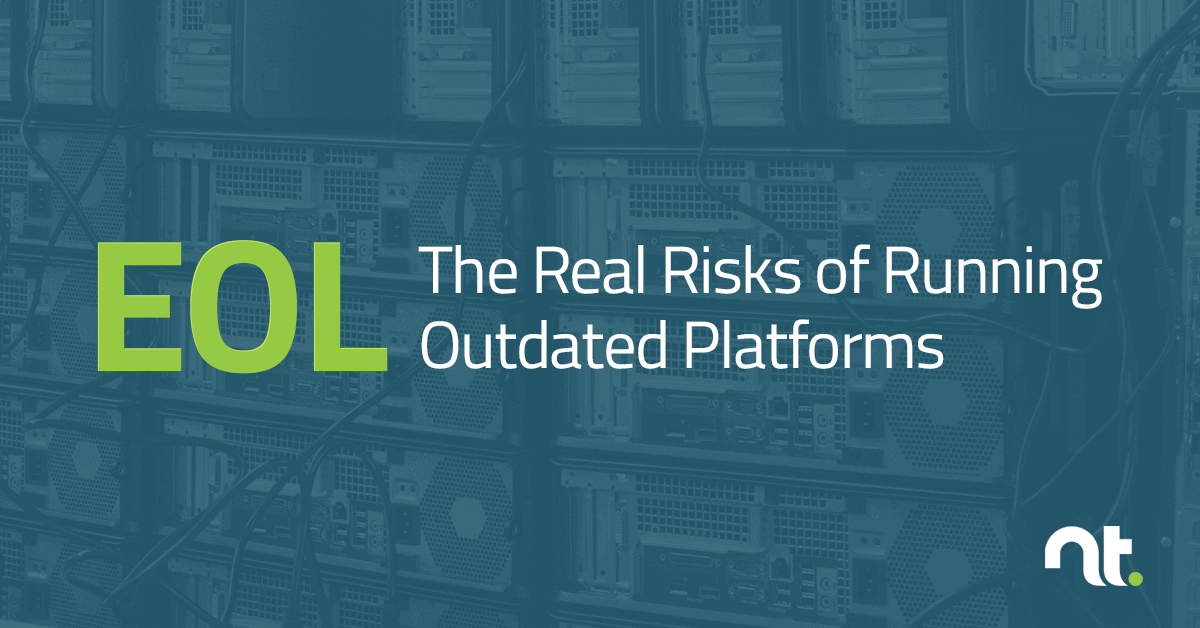READ TIME: 3 MIN

EOL: The Real Risks of Running Outdated Platforms
Advancements in technology move at a faster pace than any other industry. The routine updates recommended for your tech assets are not meant to annoy you, although it may seem that way. In short, the improvements being developed are purposeful for security reasons and to optimize efficiency.
The same goes for End of Life announcements by technology brands. By definition, the term “End of Life” (EOL) refers to a product’s lifecycle. As new products are being introduced by say, Microsoft, former products are phasing out. End of Life means the product, whether it is software or hardware, will no longer be supported including important security patches that protect your infrastructure.
Here are a few things you should know about EOL:
Security Hazards Ahead
A firewall and anti-virus are not enough protection against unpatchable vulnerabilities, which hackers are quick to exploit. Your End of Life (EOL) technology is an easy target. Hackers have much more knowledge and resources than ever before and they are looking for an “in” or weakness in your network. Don’t be an easy target!
Trusting Old Operating Systems (OS) and Applications with Critical Data
If you’re like most companies today, you have some compliance requirements. And, you know you’re under the watchful eye of the regulatory industry. Your sensitive customer data is the underpinning of your entire organization and your decade-old Operating Systems (OS) or unsecure applications put you at risk for a potential security breach or Ransomware attack. The first step in staying compliant is as easy as picking up the phone and setting an appointment with your managed IT services provider.
Legacy Applications Keep Your Business From its Full Potential
Technology advancements help your business run more efficiently and securely and staying up-to-date can position your company as a market leader. New applications are optimized to utilize the features of the most recent operating systems. That means when using EOL software, you can’t upgrade to the latest and greatest, leaving you with those legacy applications (which are likely also EOL or soon to be). Don’t fall behind your competitors simply because your technology is antiquated.
Uptick in Operating Costs of Post–EOL Tech
As a business leader/owner, you have enough decisions to make. Hiring, P/L, payroll, etc. – which is why you have an in-house or outsourced managed IT provider. Often, investing in an upgrade project receives a red flag from your finance team, but is the right decision over the security issues of running post-EOL technology and mission-critical apps at risk of failing. The cost of a cyberattack or unplanned downtime will most definitely cost more than the planned investment to secure your systems and data.
Downtime Costs vs Investing in Uptime
Chances are, if you’re still running legacy apps or old versions of Windows (as well as aging servers and workstations), you are adding to your risk because the EOL software and out-of-warranty devices are prone to causing significant vulnerabilities and downtime. Consider that significant downtime alone is costlier than moving forward with an upgrade. The best approach is to be proactive when it comes to your technology environment, versus reactive.
For many, Microsoft’s announcement to terminate support for Windows 7 and Windows 8 may a blessing in disguise. Running older systems can be keeping you from realizing your full potential as a business where efficiencies and the ever-evolving security threats are concerned.
Give NexusTek a call to learn more about an upgrade project before your tech reaches “End of Life!”